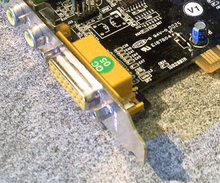Gameport

A DA-15 connector on a sound card
|
|||
| Type | Joystick input port | ||
|---|---|---|---|
| Designer | IBM | ||
| Superseded by | USB | ||
| Hot pluggable | yes | ||
| External | yes | ||
| Pins | 15 | ||
| Connector | DA-15 | ||
 |
|||
| Pin 1 | +5V | +5 V DC | |
| Pin 2 | B1 | Button 1 | |
| Pin 3 | X1 | X-axis for joystick 1 (0–100 kΩ) | |
| Pin 4 | GND | Ground for B1 | |
| Pin 5 | GND | Ground for B2 | |
| Pin 6 | Y1 | Y-axis for joystick 1 (0–100 kΩ) | |
| Pin 7 | B2 | Button 2 | |
| Pin 8 | +5V | +5 V DC | |
| Pin 9 | +5V | +5 | |
| Pin 10 | B4 | Button 4 | |
| Pin 11 | X2 | X-axis for joystick 2 (0–100 kΩ) | |
| Pin 12 | GND | Ground for buttons 3 and 4 (or MIDI out) | |
| Pin 13 | Y2 | Y-axis for joystick 2 (0–100 kΩ) | |
| Pin 14 | B3 | Button 3 | |
| Pin 15 | +5V | +5 V DC (or MIDI in, sometimes unconnected) | |
The game port, originally introduced on the Game Control Adapter, is a device port that was found on IBM PC compatible and other computer systems throughout the 1980s and 1990s. It was the traditional connector for joystick input, and occasionally MIDI devices, until replaced by USB in the 21st century.
Originally located on a dedicated expansion card, the game port was later integrated with PC sound cards, and still later on the PC's motherboard. During the transition to USB, many input devices used the game port and a USB adaptor in the form of a cable expansion.
The game port first appeared during the initial launch of the original IBM PC in 1981, in the form of an optional US$55 expansion card known as the Game Control Adapter. The design allowed for four analog axes and four buttons on one port, allowing two joysticks or four paddles to be connected via a special "Y-splitter" cable.
At the time there was no sort of industry standard for controller ports, although the closest was the Atari joystick port. This was originally introduced in 1977, on the Atari VCS, and by 1981, was used on both Atari gear and the Commodore VIC-20. But it could not be considered truly widespread until around 1983, when it appeared on the Commodore 64 and several other platforms. In contrast with the IBM design, the Atari port was primarily designed for digital inputs, specifically eight-direction joysticks. It did include two analog inputs as well, which could support a single analog joystick, but these were not widely used. The Apple II also sported a joystick port with enough channels for two joysticks, but only one button per stick. The BBC Micro had a similar port to the IBM design, even using the same 15-pin connector, but was wired in such a way to support only one fire button per stick. In most respects, the IBM design was similar or more advanced than existing designs.
...
Wikipedia
